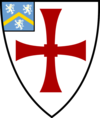Durham University Oriental Museum
| Established | 1960 |
|---|---|
| Location | Durham, County Durham, United Kingdom |
| Coordinates | 54°45′50″N 1°34′53″W / 54.764°N 1.5815°W |
| Visitors | 19,263 (2009/10)[1] |
| Curator | Craig Barclay |
| Website | http://www.dur.ac.uk/oriental.museum/ |
The Oriental Museum, formerly the Gulbenkian Museum of Oriental Art and Archaeology, is a museum of the
History
Founded in 1960 to support the university's teaching and research in the Oriental School, the collections of the museum have largely grown through donations and purchases to support cultural studies alongside the teaching of languages. The museum's initial collection arose from the sale of the antiquities of Algernon Percy, 4th Duke of Northumberland, from Anatolia, Mesopotamia and Ancient Egypt. The collection arrived in late 1950 being initially housed in two rooms (one for display, one for storage) in Hatfield College. After this was forced to close in 1956, much of the collection was placed in storage.[4]
The establishment of Raymond Dawson as
The growth of the school led to the school moving to Elvet Hill House, where the current location of the museum is set, on the south edge of Durham. With part of the collection still held at various sites and the success of the initial exhibitions potential donors were sought for the formal establishment of a museum. A successful bid was made to the
In October 1969 a fragment of Moon rock was sent to the university's department of earth sciences. Prior to undergoing analysis the rock was displayed at the museum for two days attracting over 12,000 people resulting in the museum opening until 8:30pm to accommodate the visitors.[5]
During 2008 the Egyptian and Chinese art and archaeology collections were granted designated status along with 150 pieces from the collections touring Japan for nine months in the Oriental Art from Durham University and Eton College exhibition attracting over 185,000 visitors.[4][failed verification]
In 2012 thieves stole Chinese artefacts worth almost £2 million. The items were recovered by police and returned to the museum.[6] In 2013 two men were found guilty of the theft and jailed.[7]
Awards
In March 2012, a national award, "The Bronze Hear by Right", was presented to the museum by the National Youth Agency.[8]
Finances
Subsequent to the Moon rock display, funding was sought to complete the second stage of the museum, however, such funds were not forthcoming and in the 1980s a competition was launched to add additional side galleries in lieu of the second stage. In 2000 further funding was secured to create a mezzanine floor to house additional artifacts from the collections.[4][failed verification]
In 2012, Culture Minister Ed Vaizey announced funding from the DCMS/Wolfson Foundation Museums and Galleries Improvement Fund. The grant, totally more than £80,000 will be used to help fund new galleries dedicated to Japan and Korea.[9][failed verification]
Collections
- China: The Chinese collection contains over 10,000 objects ranging from the Charles Hardinge donation.[10]
- Korea: Containing just over 500 pieces, the collection is one of the smallest with objects from the Joseon dynasty including bronze mirrors and ceramics with sanggam decoration. The collection is predominantly composed of the donations from Richard Rutt and Henry de Laszlo. Recent acquisitions of contemporary Korean culture and art have been made possible by the Stories of the World project and the Art Fund, resulting in the Korean collection encompassing the time period from 600 AD to 2013.[11]
- Indian subcontinent: Ranging from stone sculptures to Gandharan sculptures the collections contains 1,500 objects, and over 5,000 photographs taken by John Marshall.[12]
- Japan: The Japanese collection spans mostly the
- South East Asia: The collection is formed mainly from two acquisitions, the Harold MacDonald collection consisting of items presented to him as Commissioner General of South East Asia, and the Roberts Collection of Balinese art.[14]
- The Levant and Middle East: The collection contains many artefacts collected from archaeological excavations such as those from Sir Lachish excavation. The core of the collection is from the Northumberland Collections consisting of seals and cuneiform tablets.[15]
- Ancient Egypt: Made up of over 6,700 objects the Egyptian collection is formed from two main acquisitions; The Northumberland collection of over 2,500, purchased from the Paser from the 19th dynasty, reign of Ramesses II.[16]
References
- ^ "Heritage Collections Annual Report 2009/10" (PDF). Durham University. Retrieved 5 March 2011.
- ^ [1] "Archived copy". Archived from the original on 27 July 2011. Retrieved 7 November 2010.
{{cite web}}: CS1 maint: archived copy as title (link) - ^ "Designated Collections | Arts Council England". www.artscouncil.org.uk. Retrieved 9 July 2021.
- ^ a b c d "History". Durham University. Archived from the original on 28 December 2010. Retrieved 7 November 2010.
- ^ ISBN 978-1-906507-35-0.
- ^ "Durham University Oriental Museum treasures recovered". BBC News. 14 April 2012. Retrieved 9 July 2021.
- ^ "Men jailed for Durham University Oriental Museum raid". BBC News. 8 February 2013. Retrieved 9 July 2021.
- ^ "Durham University's Oriental Museum achieves national award - Durham University". www.dur.ac.uk. Retrieved 9 July 2021.
- ^ "Oriental Museum - Durham University". www.dur.ac.uk. Retrieved 9 July 2021.
- ^ "Chinese". Durham University. Retrieved 7 November 2010.
- ^ "Korea". Durham University. Retrieved 7 November 2010.
- ^ "Indian". Durham University. Retrieved 7 November 2010.
- ^ "Japanese". Durham University. Retrieved 7 November 2010.
- ^ "South East Asia". Durham University. Retrieved 7 November 2010.
- ^ "Near & Middle East". Durham University. Retrieved 7 November 2010.
- ^ "The Oriental Museum". Association of Curators for Collections of Egypts and Sudan. Archived from the original on 23 December 2012. Retrieved 7 November 2010.


